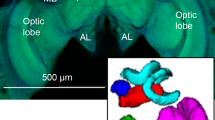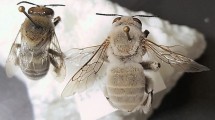Abstract
Most animals show long-term modifications of their behavior which often reflect an adaptation to seasonal variations (e.g., hibernation) or result from changes in the animal's internal state (e.g., estrous cycle or sexual maturity). Such modifications may substantially affect the nervous system [1, 2]. A particularly striking behavioral change can occur in workers of the ant Harpegnathos. A few young workers in the colony may become reproductives and are thus confined to their dark nest chambers, whereas most workers spend their lives as foragers, employing acute vision when hunting prey. This behavioral difference coincides with a marked decrease in brain volume and with an even stronger reduction in the large visual brain centers. Instead of maintaining superfluous brain functions, these ants reduce brain matter which is expensive to support.
Similar content being viewed by others
Author information
Authors and Affiliations
Additional information
Received: 8 September 1998 / Accepted: 16 March 1999
Rights and permissions
About this article
Cite this article
Gronenberg, W., Liebig, J. Smaller Brains and Optic Lobes in Reproductive Workers of the Ant Harpegnathos. Naturwissenschaften 86, 343–345 (1999). https://doi.org/10.1007/s001140050631
Issue Date:
DOI: https://doi.org/10.1007/s001140050631




